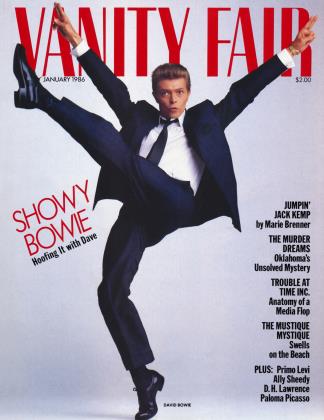Sign In to Your Account
Subscribers have complete access to the archive.
Sign In Not a Subscriber?Join NowLeon Golub's Grave Images
VISUAL ART
Gerald Marzorati
Leon Golub, our great Conradian painter, has had a breakthrough; he's found a way to paint the victims of power upriver, where the wires fray. In the paintings of torturers and mercenaries and death-squad goons that Golub has done in recent years—paintings that, in this figurative moment, have brought him fame, and by his standards fortune—it's the wielders of power you identify with. They're the only ones with identities; those at the hands of these politico-thugs, whether in the jungle or in the street, are little more than limp, fleshy lumps.
But in the possibilities opened up by these paintings, and in the painstaking method that he has taken most of his life to master (he will be sixty-four this month), Golub has found a way to push against power's ugly logic—the way it has of reducing what it fears and hates to things. In two new paintings, each a monumental portrait of poor, history-weathered South African blacks, he has managed to depict the powerless as subjects, and without sentimentality or any trace of the picturesque. Both of these paintings are included in a show of Golub's work this month at the Barbara Gladstone Gallery in New York.
Golub began the first of these "Blacks," as he calls them, last winter. "In a funny way," he recalls, "I'd come to see that I rendered blacks better than whites. The black mercenaries are individualized; in some paintings the whites are caricatured a bit. Maybe with the blacks I had this greater distance. But then, what the hell did I know about poor blacks, ones without power? So I saw it as a challenge—to get inside them, like I've gotten inside the other blacks I've done."
The details, the hard-earned specifics, help you to "read" Golub9s blacks as South Africans.
To get inside takes time. Golub works slowly, finishing five, maybe six paintings a year. This in part explains why they are priced at $60,000. (Both the "Blacks" have already been sold: one to the Smithsonian's Hirshhom Museum, the other to the Los Angeles collector Eli Broad.) The sheer scale Golub works at slows things down; the "Blacks" are each ten feet high and more than fifteen feet wide. Mostly, though, it's a matter of his method. The rough drawing alone can take weeks; in sketching a big figure, he may utilize bits and fragments of the thousands of news photos he's collected, projecting some directly onto the canvas, blending and fitting in his puggoofy style until body, face, and clothing are fully of his own making. He then applies layer after layer of acrylic—only to scrape every inch of it off, leaving no more than what has soaked into or been rubbed onto the tooth of the canvas. There follow many sessions devoted to the finest details of the eyes and mouths and hands; he wants to get those crucial carriers of human revelation to work.
Golub is convinced that the months he spends with a picture are not only a methodological necessity but what might be called a literary one. It's the way, he says, that "I get to know these characters I paint, to see how I feel about them. My feelings can change. When I paint, I'm inside and outside." He sounds like a nineteenth-century novelist, a Zola or Balzac. And he's after what they got—that deep, swampy, yet always specific complexity of content and feeling that emerges through art-making itself.
The details, the hard-earned specifics, help you to "read" Golub's blacks as South Africans. The backgrounds are washy white dampened in spots to gray, and gridded to look like cement blocks; these are the sides of the quick-built housing that you see in photos of black townships like Soweto. And the clothing is too dated and "off" (slacks rolled to the knee?), and too empty of consumer signs, to be inner-city American or Caribbean.
In both of the paintings, four blacks sit on the ground—on whatever's around—and face front, looking out at you. Each is his own, thorny man (in one case, woman); Golub hasn't figured them out for you. In Four Black Men, the first one Golub completed, the blacks are workers approaching middle age; they have stevedore arms, but they're tired, the kind of tired where a good night's sleep isn't the answer—everybody's got bloodshot eyes. But the eyes are still alert, maybe even a little threatening, or feigning this toughness
as a reflex, sensing a threat: What are you doing here? In 4 Blacks, the subjects are older. Golub's scraping (he uses a meat cleaver) has made the skin look time-leathered—the browns and blacks are like steel-wooled teak and ebony. And the bodies sag with brute grief. Not only do these old blacks look you over, they talk and gesture at you. They haven't gone where they've want-
ed to, but they won't budge either.
In his recent book about South Africa, Waiting, the anthropologist Vincent Crapanzano writes, "For most Blacks . . . waiting is illuminated by... a belief that time is on their side." In the steadied, stubborn bodies, in the haggardeyed faces that won't turn away, in every sad but obdurate detail, this is what Golub has painted.
 View Full Issue
View Full Issue


















Subscribers have complete access to the archive.
Sign In Not a Subscriber?Join Now